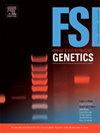在最小的混合法医染色中识别同卵双胞胎兄弟作为DNA供体-一个案例
IF 3.1
2区 医学
Q2 GENETICS & HEREDITY
引用次数: 0
摘要
在法医案件工作中,同卵双胞胎一直是一个挑战,因为常规使用的法医短串联重复(STR)图谱无法区分双胞胎个体。在本研究中,我们应用了一种方法来区分性侵犯案件中的两个同卵双胞胎兄弟,这是一个独特的和具有挑战性的原因:使用接触染色作为证据,染色含有两个人(受害者和兄弟中的一个)的DNA, DNA含量极低,并且存在PCR抑制因子。尽管存在这些具有挑战性的因素,我们提出了一个成功解决的案例,其中全基因组测序被应用于识别两兄弟之间的多个体细胞差异。在将该方法应用于两种证据污点之前,对两兄弟姐妹提供的材料进行了开发方法和鉴定差异的验证。开发了一个统计框架,为混合染色中这种类型的分析提供了似然计算。结果被法庭接受,并有助于对案件嫌疑人定罪。在这里,我们提供了科学的细节,以鼓励在未来更多的此类情况下使用这种方法。本文章由计算机程序翻译,如有差异,请以英文原文为准。
Identifying a monozygotic twin brother as a donor of DNA in minimal, mixed forensic stains – A case example
In forensic casework, monozygotic twins have always provided a challenge, as routinely used forensic Short Tandem Repeat (STR) profiles are not able to differentiate between the twin individuals. In this study, we applied a method to discriminate between two monozygotic twin brothers in a sexual assault case that is unique and challenging for several reasons: the use of contact stains as evidence, the stains contain DNA from two persons (victim and one of the brothers), have minimal amounts of DNA, and there are PCR inhibiting factors. Despite these challenging factors, we present a successfully solved case in which whole genome sequencing was applied to identify multiple somatic differences between the two brothers. Validation of the developed methods and the identified differences was performed on material provided by the two siblings, before applying the method on two evidentiary stains. A statistical framework was developed to provide a likelihood calculation for this type of analysis in mixed stains. The results were accepted in court and contributed to the conviction of the case suspect. Here we provide the scientific details in order to encourage the use of this approach in more such cases in the future.
求助全文
通过发布文献求助,成功后即可免费获取论文全文。
去求助
来源期刊
CiteScore
7.50
自引率
32.30%
发文量
132
审稿时长
11.3 weeks
期刊介绍:
Forensic Science International: Genetics is the premier journal in the field of Forensic Genetics. This branch of Forensic Science can be defined as the application of genetics to human and non-human material (in the sense of a science with the purpose of studying inherited characteristics for the analysis of inter- and intra-specific variations in populations) for the resolution of legal conflicts.
The scope of the journal includes:
Forensic applications of human polymorphism.
Testing of paternity and other family relationships, immigration cases, typing of biological stains and tissues from criminal casework, identification of human remains by DNA testing methodologies.
Description of human polymorphisms of forensic interest, with special interest in DNA polymorphisms.
Autosomal DNA polymorphisms, mini- and microsatellites (or short tandem repeats, STRs), single nucleotide polymorphisms (SNPs), X and Y chromosome polymorphisms, mtDNA polymorphisms, and any other type of DNA variation with potential forensic applications.
Non-human DNA polymorphisms for crime scene investigation.
Population genetics of human polymorphisms of forensic interest.
Population data, especially from DNA polymorphisms of interest for the solution of forensic problems.
DNA typing methodologies and strategies.
Biostatistical methods in forensic genetics.
Evaluation of DNA evidence in forensic problems (such as paternity or immigration cases, criminal casework, identification), classical and new statistical approaches.
Standards in forensic genetics.
Recommendations of regulatory bodies concerning methods, markers, interpretation or strategies or proposals for procedural or technical standards.
Quality control.
Quality control and quality assurance strategies, proficiency testing for DNA typing methodologies.
Criminal DNA databases.
Technical, legal and statistical issues.
General ethical and legal issues related to forensic genetics.

 求助内容:
求助内容: 应助结果提醒方式:
应助结果提醒方式:


